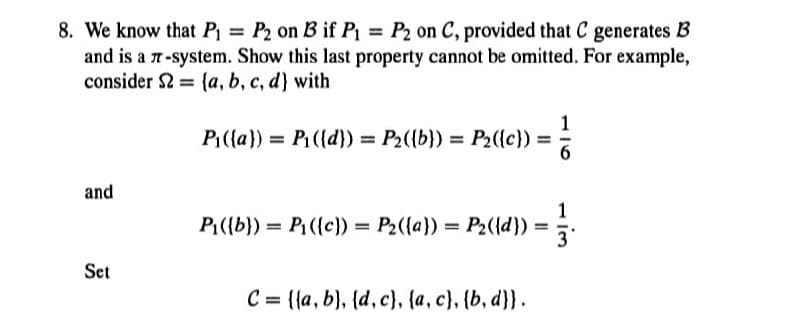8. We know that P₁= P2 on B3 if P₁ = P2 on C, provided that C generates B and is a 7-system. Show this last property cannot be omitted. For example, consider 2 (a, b, c, d) with = 1 P₁({a})= P₁({d})= P₂({b})= P₂({c})= and 1 P₁{{b}) = P₁({c}) = P₂{{a}}) = P2({d}) = 3. Set C= {(a, b), (d, c), (a, c}, {b, d}}.
8. We know that P₁= P2 on B3 if P₁ = P2 on C, provided that C generates B and is a 7-system. Show this last property cannot be omitted. For example, consider 2 (a, b, c, d) with = 1 P₁({a})= P₁({d})= P₂({b})= P₂({c})= and 1 P₁{{b}) = P₁({c}) = P₂{{a}}) = P2({d}) = 3. Set C= {(a, b), (d, c), (a, c}, {b, d}}.
Linear Algebra: A Modern Introduction
4th Edition
ISBN:9781285463247
Author:David Poole
Publisher:David Poole
Chapter2: Systems Of Linear Equations
Section2.4: Applications
Problem 1EQ: 1. Suppose that, in Example 2.27, 400 units of food A, 600 units of B, and 600 units of C are placed...
Related questions
Question

Transcribed Image Text:8. We know that P₁= P2 on B3 if P₁ = P2 on C, provided that C generates B
and is a 7-system. Show this last property cannot be omitted. For example,
consider 2 (a, b, c, d) with
=
1
P₁({a})= P₁({d})= P₂({b})= P₂({c})=
and
1
P₁({b}) = P₁({c}) = P₂{{a}} = P2({d}) = 3.
Set
C = {(a, b), (d, c), {a, c}, {b, d}}.
Expert Solution
This question has been solved!
Explore an expertly crafted, step-by-step solution for a thorough understanding of key concepts.
Step by step
Solved in 2 steps with 1 images

Recommended textbooks for you

Linear Algebra: A Modern Introduction
Algebra
ISBN:
9781285463247
Author:
David Poole
Publisher:
Cengage Learning

Linear Algebra: A Modern Introduction
Algebra
ISBN:
9781285463247
Author:
David Poole
Publisher:
Cengage Learning